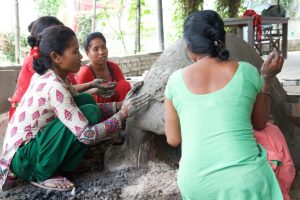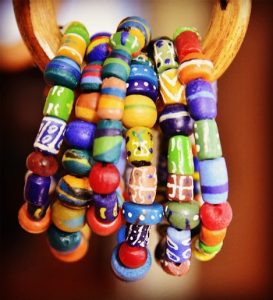Kintsugi, the Japanese art of repairing broken pottery with powdered gold believes in embracing the flawed. Following the similar philosophy, Marie Ange Sylvain, founder of Bottles to Beads started her social enterprise that uses discarded glass bottles to make jewelry. She came to a country with a language completely different than hers and used beads to communicate and create a bond between different people of different origin. Follow us as we take you along the journey of converting junk to jewelry in this interview with Marie Ange Sylvain, a story from trash to beads.
How did you come up with the idea for bottles to beads?
I lived in Africa for a few years where I saw women make their own beads out of recycled glass. I wanted to replicate the same in Nepal as people were importing beads and just stringing them. It would give employment to women, clean the environment and the raw material was free as it’s made out of discarded bottles. On the other hand, I like the idea of beads because almost all cultures use beads in some form or the other, it was used as currency for trading at some point and there is jewelry. In that sense, beads are a universal language. True to that, I didn’t have to say anything to the women I work with, I just had to show them how beads are made.
I personally didn’t know how to make beads, so I invited a trainer from Ghana who trained the women for 3 months. Right from making the mud kiln to the actual process of crushing, molding and baking were covered in the workshop. This enables the women to work without any assistance, using local materials which are at their disposal. So, it is quite versatile and adaptable.
What was your purpose for coming to Nepal and what are you doing now?
I was working for the UN before and I wanted to continue doing what I was doing as a job but for myself. So, I came to create Image Ark which is a communication company. I also have another initiative called Piya which is a new brand of high-end decorative objects which are all hand made. I was astounded with the handicrafts I saw in Nepal so I wanted to do justice to their craftsmanship. And I oversee Bottles to Beads. It’s tiring to manage three different companies, but I like the diversity of it.
How many women are associated with Bottles to Beads and how did you recruit them?
We’ve trained around 40-50 women; some continue to make beads some don’t. We do have a core team of 7-8 women who always make beads and are committed to Bottles to Beads in our workshop. For recruitment initially, I spoke to a few women but now it happens mainly through word of mouth. Women hear about us and approach us. My core group understands what I want and when they go for workshops, they communicate what we do and who are the people we are looking for. We are currently working in Dhading, Rasuwa, Panauti, Dang, and Kathmandu.
What are the kinds of challenges faced by your startup?
Women who come for training are of different caste and a hierarchy can be noticed within the workshop. We try to break that by teaching them that nothing is beneath them no matter what their caste and ethnic background are. Over time women do get along and the atmosphere is beautiful. They work together quietly without any pressure because it’s a recycling business. Even if they break something, they can make it again. In this job, they can’t go wrong and they need to know that.
Some women cannot continue bead making because they can’t set up a workshop (kiln) at their home and some leave because their partners don’t allow them to work. The training takes 3-4 months and their family needs them which is a challenge.
How did you find the market for your product?
Well, it was mostly word of mouth marketing. I wrote to a few people who buy beads from Nepal. We made a website and put the beads here in our gallery for display. Our first customer was from California who still orders from us. We’ve clients in Australia, Sweden, Germany. We have an art market in Kathmandu and Pokhara where we sell these beads. Also, it’s not a big enterprise so these clients are enough for Bottles to Beads sustainability.
What is the structure of the organization?
It’s been an informal structure and still evolving. Women who joined us in the initial days were trainees then they became employees and now, they manage the whole operation. In the beginning, I used to give them a salary. Now that we are selling they also manage the money. After a sale, they distribute the money among themselves and also pay money to women to send us their beads. My part in the business now is just promotion and finding clients.
How did you manage the funds and finances?
The main expense was getting a trainer from Africa and hosting him. I had to support the trainer because these women didn’t have anything. Besides that, I also financed to build the workshop, paid the salary of the women for two years. I stopped injecting money only after it started being self-sufficient. It was gradual but it’s happened. A few months ago, I mentioned I was going to a fair and Shanti (women from the core team) asked how much money I needed. That was a proud moment for me.
How do you pay these women?
It is very labor intensive. Each bead is made by hand and a complete process to make one bead takes one whole day. Women in the workshop are paid a salary because they are also trainers. The women in Dhading are paid per bag of beads. They’ve arranged themselves to make money out of the sale but the decision doesn’t belong to me. They have a bank account and they make their own decision.
How do these women manage the business?
They have started understanding HR and what a proper working practice is. Even when someone is sick, they take out money from their account and help, they give each other loans and they have to pre-inform in case of absence. We have a workshop manager Shanti who looks after this. A woman from Rasuwa said that it was the first time in her life when she was complimented for her work and she is proud of that. They didn’t know that feeling and it’s a big confidence boost for them. They take pride in the work they do and even emotionally, it has done them good. I still want them to know the value of their work because they are still making products that don’t have cultural significance.
Want to learn more about Bottles to Bead? Check out their website here to see their amazing products or Facebook profile here for more updates.











